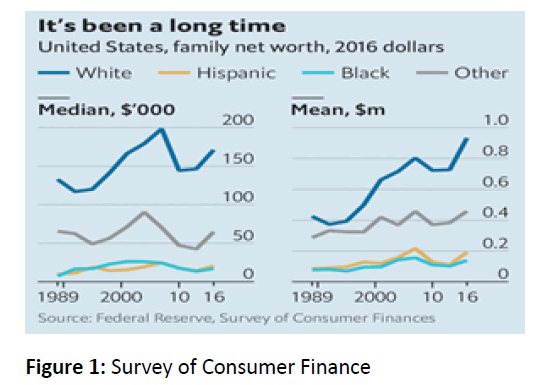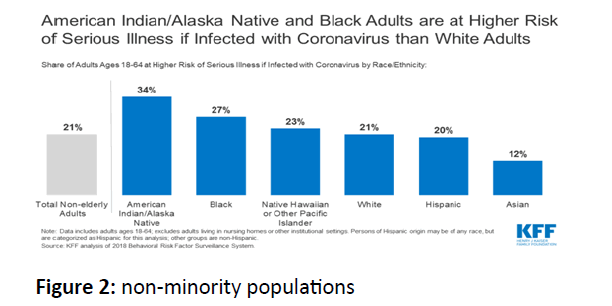Akhil Pedada*
Department of Medical Science, American University, Washington, USA
- *Corresponding Author:
- Akhil P
Department of Medical Science, American University, Washington, USA
E-mail: akhilpedada410@gmail.com
Received Date: February 05, 2021; Accepted Date: February 19, 2021; Published Date: February 26, 2021
Citation: Akhil P (2021) The COVID-19 Pandemic: An American Health Divide. Divers Equal Health Care Vol.18 No.3: 557.
Copyright: © 2021 Akhil P. This is an open-access article distributed under the terms of the Creative Commons Attribution License, which permits unrestricted use, distribution, and reproduction in any medium, provided the original author and source are credited.
Description
In a 2019 study by Harris County Health System, Houston, Texas, Dr. Umair Shah, Director of Harris County Public Health, stated; “Where you live often determines how well and how long you live”. This statement by Dr. Shah describes the well documented fact that African- Americans and other ethnic minorities living in underserved communities in Harris County or perhaps what should more appropriately be called “under-resourced” [1]communities are at greater risk of infections from the COVID-19. The COVID-19 Pandemic has led to tracking by targeted zip codes. The results show that, in U.S., there is a higher incidence of COVID -19 in under- resourced than non-under resourced communities [2]. Besides being under-resourced or underserved, there are also some long-term social factors that significantly contribute to and serve as determinants of the quality of health and social wellbeing of African- Americans and other ethnic minorities. These include: low income, overcrowded housing for family size, poor nutrition, limited education, and access to poor healthcare. (See Federal Reserve, Survey of Consumer Finance) Figure 1 [3].
Figure 1: Survey of Consumer Finance
The Civil Right Bill of 1965 (CRB ‘65) removed some of the Jim Crow Laws that proved to be structural and cultural barriers to Blacks entering mainstream society. However, the effects of social isolation caused by segregation have had long term adverse effects on the biological, physiological and behavioral health of Blacks and other ethnic minorities [4]. To a large extent, research is still lacking to better understand and improve the quality of health for future generations of African Americans. According to the Center for Disease Control (CDC) and the World Health Organization (WHO), health is defined as: the physiological, mental and social well-being of a person or group. Historically, [5] it is well documented that African Americans born out of American Slavery have traditionally been inhabitants of socially impoverished conditions. Fast forwarding to the present, African Americans remain the most socially vulnerable and the ethnic group suffering from the highest rate of chronic diseases. These diseases include: Diabetes, Hypertension, Obesity, Chronic Obstructive Pulmonary Disease (COPD) and Mental Illnesses. According to the Office of Minority Health (OMH), these chronic diseases have contributed to African Americans having the highest mortality rate associated with COVID-19 deaths [6].
Moreover, African Americans and other ethnic minorities have been exposed for many generations to long-term toxins in workplace and other non-workplace environments. There are also toxins that African Americans and other ethnic minorities have had long term exposure to that are extremely damaging to their health and well-being [7]. These toxins are well known as toxic behaviors are associated with mental and/or chronic diseases. Veldsman, T (2016). There are also a number of other social factors in society that contribute to the disproportionate burden of public health crises on certain populations. These include socioeconomic status, age, ethnicity, Limited English Proficiency (LEP), overcrowded housing for family size, limited vehicle access and other cultural and structural barriers. For example, due to cost, African Americans are more likely than whites to lack health insurance coverage. African Americans are therefore more likely to go without needed care. African Americans are more likely to distrust the healthcare system. African Americans also, very frequently, encounter a language barrier and discrimination because they speak English less than very well, OMH (May11 2020) [8]. Approximately eight percent of U.S. residents report speaking English less than very well and one in five U.S. residents speak a foreign language at home, at the age of 10. This equates to more than 61 million people, ( OMH 2020). One in five adults in the U.S. have limited English literacy levels, of which 34% are Hispanic and 23% are Blacks. African Americans and other ethnic minorities live in areas that are further from high quality medical facilities or where medical facilities are well resourced [9]. A recent study by the OMH showed African Americans and other ethnic minorities are generally more vulnerable to the negative impact of public health emergencies and disasters. Another study also showed that Blacks who were exposed to the health effects of Hurricane Katrina developed higher risk of Chronic Obstructive Pulmonary Diseases (COPD) from exposure to mildew and mold Doheny, K. (2017) [10]. This study is consistent with the OMH 2020 study that found African-Americans and other ethnic minorities experienced higher rates of injury, diseases, traumatic stress, death and loss due to public health emergencies than nonminority populations Figure 2.
Figure 2: non-minority populations
A study by the Kaiser Family Foundation, KFF( 2018) also found people with low household income are at higher risk of serious illness when infected with the coronavirus .This study indicate that the age range of population studied were adults 18-64.As shown in the chart below, (figure 2)of the total population studied , 21percent were non-elderly adults. What is very, very revealing in this KFF study is that based on the income level of non-elderly adults, the lower the house income level, the higher the risk of coronavirus infection.
The point being made in the citation of the foregoing studies is that, a number of health and social challenges place African Americans and other ethnic minority populations at higher risk for poor health in the aftermath of the COVID-19 pandemic. This includes higher mortality, more medical complications, limited access to health care, lower annual influenza vaccination rates, greater socioeconomic, cultural, educational and linguistic obstacles to the adoption of pandemic interventions. The OMH 2020 data collection from the COVID-19 pandemic suggests that African Americans and other ethnic minority populations bear a disproportionate burden of illness and death from the COVID-19 [11].
The decline and paucity of black professional schools has also contributed to the health inequity in African-Americans and other ethnic minority populations. As the United States population continues to grow in number, age and diverse cultures, the need for medical facilities in the under-resourced communities will also continue to grow. Currently there are 100 plus Historically Black Colleges and Universities (HBCU’s) that are adjacent to under resourced communities. However, in the entire United States, as compared to their white counterparts, there are only (4) Black medical schools, seven (7) Black pharmacy schools and forty(40) Black nursing schools to serve the under-resourced communities [6]. Hence, the disproportionate number of black physicians as compared to white physicians also contributes to the socioeconomic and health/healthcare inequities or needs in under resourced communities.
Today, the shortage of physicians is being offset by the rapid advancement in computer technology or what is called tele-health [9]. This is making it necessary for HBCU’s to expand their health curricula into non-traditional roles in healthcare delivery. That is, HBCU’s must now integrate tele-health into their curricula as an outreach to the under-resourced communities. The expanded HBCU curricula not only promote closer communications between HBCU’s and the adjacent communities, this non-traditional HBCU role has also become important in the removal of cultural and structural barriers. Specifically, this non-traditional HBCU role reverses the inequities that exist in the health and healthcare of under-resourced communities. The formation of Community University Task Force Committees can also be used to better coordinate different community groups to expand the role of HBCUs as institutions of higher learning [12].
Conclusion
The primary goal of such joint task force committees would be the prevention and treatment of the aforementioned chronic diseases in African American and other ethnic minority populations. The chronic diseases referenced here are: Obesity, Diabetes, Hypertension, Chronic Obstructive Pulmonary Diseases (COPD) and other respiratory diseases e.g. COVID-19 and mental illness.
References
- Felippe de Souz J, Caetano M, Yoneyama T. (2000) Optimal control theory applied to the anti-viral treatment of AIDS. in Proceedings of the 39th IEEE Conference on Decision and Control. 4839-4844.
- Al-bukhari A, Hallett S, Brewer T. (2018) A review of potential methods for monitoring rangeland degradation in Libya. Pastoralism.8:13.
- Al-Rowaily SL, El-Bana MI, Al-Bakre DA, Assaeed AM, Hegazy AK et al. (2015) Effects of open grazing and livestock exclusion on floristic composition and diversity in natural ecosystem of Western Saudi Arabia. Saudi J Biol Sci.22:430-437.
- Asmare MT, Gure A. (2019) Effect of exclosure on woodyspecies diversity and population structure in comparison with adjacent open grazing land: the case of Jabi Tehnan district north western Ethiopia. EHS. 5:98-109.
- Bacha D, Taboge E. (2003) Enset Production in West Shewa Zone. Ethiopian Agricultural Reasearch Organization. 45.
- Bedunah DJ, Angerer JP. (2012) Rangeland Degradation, Poverty, and Conflict: How Can Rangeland Scientists Contribute to Effective Responses and Solutions. Rangel Ecol Manag. 65: 606-612.
- Cardinale1 BJ. Duffy JE, Gonzalez A, Hooper DU, Perrings C. et al. (2012). Biodiversity loss and its impact on humanity. Nature 486:59-67.
- Coppock DL. (1994) The Borena plateau of Southern Ethiopia: Synthesis of pastoral research, development and change. International Livestock Center for Africa. 299.
- Crawley MJ, Harral JE. (2001) Scale dependence in plant biodiversity. Sci. 291:864-868.
- Crawley MJ. (1986) The structure of the plant communities. In: M.J. Crawley, (ed.)Plantecology, Blackwell. 1-50.
- DarkohM BK. (2009) An overview of environmental issues in Southern Africa. Afr J Ecol. 47:93-98.
- Eriksen SHE, Watson HK. (2009) The dynamic context of southern African savannas: investigating emerging threats and opportunities to sustainability. Environ. Sci. 12:5-22.



